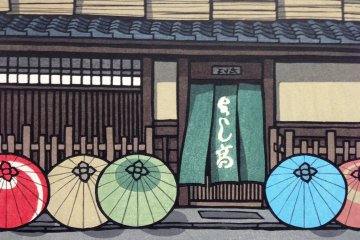Impressions of the ancient capital of Kyoto stir up an overwhelming image. The silhouettes you may glimpse around Tō-ji Temple during the early evening may in fact be the elusive figures of maiko and geigi (Kyoto dialect for geisha). These ladies of grace perform their professional dances to entertain. Their skill and charm have been passed down for centuries, becoming a part of Kyoto culture. Kagai (花街), a famous entertainment area in Kyoto's Gion district, is well known by its Japanese (and increasing number of international) fans.
I decided to enjoy a twilight stroll. It was the seventh month of the lunar calendar.
Branches of cherry trees hang low over the Shirakawa River. Hidden among their intertwined branches, I appreciate the young sprouting leaves. The shining sun seems to ignore those enjoying nature's beauty. Instead it assaults those busy bodies clambering up and down the cobble stone streets.
Starting from the west side of Gion I walk along teahouses with their bamboo blinds dyed the color of a red setting sun. From somewhere, the sound of a shamisen (three string guitar) spills into the alley. An assistant from a nearby restaurant or ryokan (Japanese style hotel) sprinkles water over the cobble stones.
A mysterious feeling sets in when traversing the streets at sunset. From Kennin-ji Temple, I continue on Hanami Lane (花見小路通) and cross Shijo Avenue (四条通). Going north on Hanami Lane, I reach Shinbashi Avenue (新橋通). From there I head west. I find myself in the vicinity of where the deity Tatsumi Daimyoujin 辰巳大明神) is enshrined. I crossed the Shirakawa Tatsumi Bridge and finally got a taste of the famous teahouses.
The Gion Shinbashi district is an area which takes pride in saving and maintaining its architectural treasures. It is one of the four such districts in Kyoto known as an ''important preservation district of historic buildings'' (伝統的建造物群保存地区). The other districts are the Kamigamo district, Sagatoriimoto district, and the Sannenzaka district. In Kyoto, there are six historic entertainment districts, but Gion is the only one being carefully preserved with such attention for its architecture and beauty.Therefore, it is easy to enjoy a leisurely stroll through the historic town and connect with its beauty. There is certainly a lingering presence of energy in the air, perhaps left from centuries of laughs, smiles, and good business of the teahouses.
The teahouses of Gion are characterized by their two-story constructions with gabled roofs. In the first year of Keio (1865), many new structures were built after a great fire ravaged the city. New teahouses featured a first floor grid pattern, a second floor with a tatami mat dining area overhanging the front of the building, and bamboo blinds all covering each window. For a building in Japan to be eligible and maintain its status as an Important Cultural Property, only the outside appearance of the structure must adhere to regulations. For that reason, it does not matter what fixtures or materials were used to construct the inside of the structure. Furthermore, you can often find inside many teahouses, businesses selling items to tourists.
You can't talk about Gion without considering its reference in the Tale of Heike's to ''Jetavana 's voice of the bell'' (祇園精舎の鐘の聲). Jetavana is the Indian monastery where Buddha preached. Yasaka Shrine houses the deity Gozu-Tenno, the guardian deity of Jetavana back in India. Originally Yasaka Shrine was known as Gion Shrine. That is why the area around the shrine is still referred to as the Gion district.
Gion was split into two districts. The first being from Yasaka Shrine and the Nishiromon Gate to Shijo Avenue, and the next along the north-south running Hanami Lane. The northeast part of eastern Gion was another part of town in addition to the four sections created from the two districts. Most people first think of Hanamachi Lane when they think of Gion. However, originally Gion's history developed around the part of town in front of Yasaka Shrine. Worshippers of the shrine and customers of the teahouses referred to the area along Yamatooji Street on the east bank of the Kamogawa River as the ''Sixth town of Gion.'' In the 17th year of Kyoho (1732), Kyoto recieved official permission from the goverment to begin construction of the teahouse quarters. Not soon after, Sueyoshicho (末吉町)、Seihoncho (清本町)、Tominagacho (富永町) 、Hashimotocho (橋本町)、Rinkacho (林下町)、and Motoyoshicho's (元吉町) ''six towns of Gion'' (祇園内六町) were developed.
Today's Gion Shinbashi district corresponds to the former Motoyoshi part of town. During the last years of the Edo era until the beginning of the Meiji period, business was absolutely booming. So much so, that it is said there were 500 teahouses at that time.
This is one of a three part series about the history of Kyoto's Gion.
1. The creation of Gion









